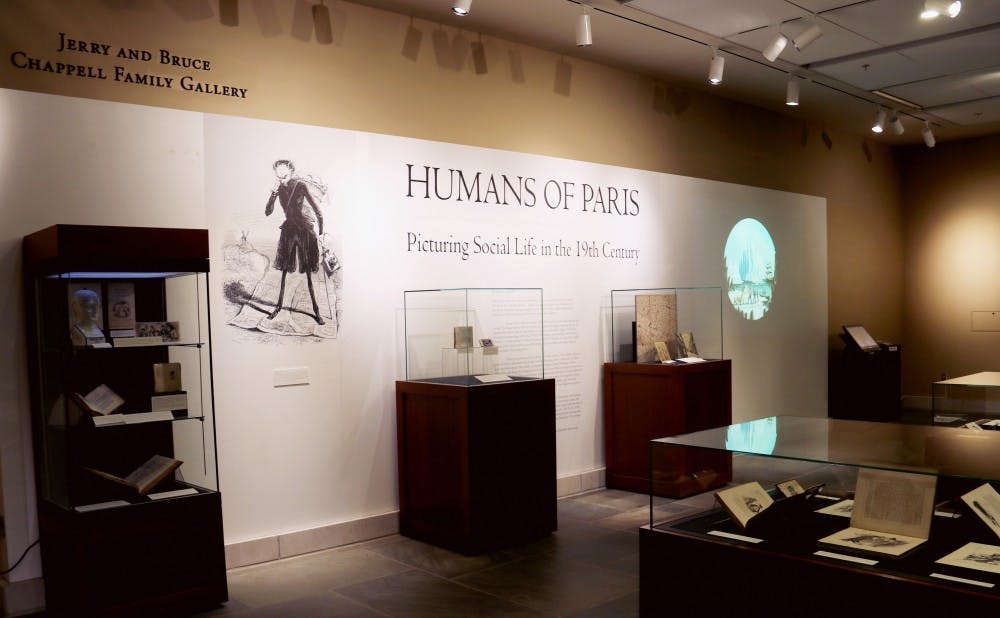Since Oct. 18, students who have walked into their second home — Perkins — with heavy steps must have been drawn by the black-and-white, visually appealing exhibit “Humans of Paris: Picturing Social Life in the Nineteenth Century” in the Jerry and Bruce Chappell Family Gallery, located between the Von der Heyden Pavilion and the first floor of the library. Curated by Kathryn Desplanque, this exhibit features Rubenstein Library’s rare books and objects that give a glimpse of social life in 19th-century Paris. It will run until Feb. 18, 2018.
An alumna of Duke’s Ph.D. program in Art History, Desplanque graduated from Duke in March before joining the Art department at UNC-Chapel Hill as a Carolina Postdoctoral Fellow for Faculty Diversity. During her study at Duke, Desplanque had been given opportunities to curate exhibits in the Duke libraries system along with other graduate students and faculty members, but “Humans of Paris” was her first individual project for the Rubenstein Rare Book and Manuscript Library.
Inspired by Brandon Stanton’s “Humans of New York” photo blog, “Humans of Paris” seeks to present the parallel between memes of today’s popular culture and viral sketch writing and comics in early 19th-century Paris. Like memes, these comics invented and reinforced stereotypes by giving them “cheeky nicknames and slang.” These sketch writing and drawings typically took the forms of illustrated pocket-sized pamphlets and collectible leaflets and were even created by famous writers and artists such as Honoré de Balzac, Alexandre Dumas, Honoré Daumier and Paul Gavarni.
Contrary to what most people today might think, memes and stereotypes are not new inventions. As a result of the rapid development of Paris in the early 19th century, small, dense streets merged into large, bustling boulevards where Parisians enjoyed strolling and being dazzled by the window dressings, street entertainment and different types of street walkers.
“At the same time caricaturists and writers start watching the watchers and become interested in who these Parisians are, and why they all look so different and funny, and what should we call them, and how we are going to describe them?” Desplanque explained.
Thus, they called working shop girls in Paris grisettes and humorously characterized their encounters with strange men. Those who successfully attracted powerful males were named lorettes, and the empowered women were also mocked by French satirists as bas-bleu (blue stockings). What’s more, slang terms like le rapin were given to lazy art students who walked the streets of Paris.
However, stereotypes and memes are a double-edged sword. In classrooms, we tend to characterize stereotypes as something negative and outdated, yet in real life we cannot help bringing them up and reinforcing them in conversations, for stereotypes are a basic framework to help us make sense of the world. The same goes for memes. We love them because they are funny and relevant, but they are also vehicles of distributing ideas that can easily be taken to the extreme.
“In a way, almost like an anthropologist, I’m interested in just saying this is something that we do, and so let’s think a little bit more about how it’s something that we’ve done in the past and we continue to do now,” Desplanque said. “We do it comedically in social satire, and social satire seems like it’s benign. Sketch comedy that one sees on SNL [Saturday Night Live] very rarely makes us worried about how we might be characterizing people from the Midwest or … Brooklyn or … people from different communities. So that stuff can fall under the radar. … I think I just advocate for thinking critically about everything, including stereotypes.”
Besides sparking discussions about the use of stereotypes and the popularity of memes, Desplanque’s exhibit also aims to make the Duke body aware of the Rubenstein Library’s treasures. Desplanque felt that Rubenstein is seldom frequented by students, especially undergraduates, unless for specific liberal arts classes or research. She was awed at the fact that so many resources — valuable rare books and objects — are available down here in the Southeast and wanted to share this awe with more people by curating an exhibit that brings the past and present together, making history relevant.
“Art and humanistic learning has to be available. It can’t hide away in an ivory tower,” Desplanque said. “I sometimes worry that undergraduates aren’t as interested in history anymore. If they take a class in the humanities, they maybe want to learn more about the 20th century and the 21st century. They want to learn about what’s happening right now because they feel that that would speak to their life much more directly. So in both my teaching and this exhibit, I want to suggest that close considerations of history can actually force us to think in very interesting ways about our own lives, and so it shouldn’t be neglected as an option for how to interrogate your living experience now in a new way.”
More specifically, Desplanque wants to pass on the message that art history does not have to be restricted to big names and big artwork in big museums and textbooks — for the arts in small illustrations and tiny copies created by lesser-known artists are equally important and compelling.
Katherine Berko contributed reporting.
Get The Chronicle straight to your inbox
Signup for our weekly newsletter. Cancel at any time.

